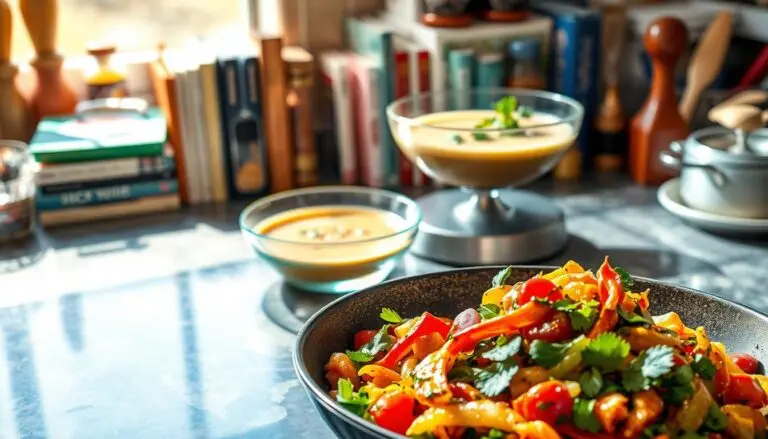Soup Abiotic Factor Explained: A Simple Guide to Understanding It
Table of Contents
Cooking is a delicate science where environmental elements play a big role. When we look at soup abiotic factor, we see how non-living parts greatly affect our food. Abiotic factor cooking shows how science and kitchen skills work together.
Every soup recipe is a complex mix of temperature, pressure, and chemical reactions. Knowing these invisible forces can make your cooking amazing. Your kitchen becomes a place where abiotic factors shape taste, texture, and nutrition.
Professional chefs know that cooking is more than just following recipes. It’s about understanding the environmental interactions in food making. By diving into soup abiotic factor, you’ll learn to make perfect dishes with skill and creativity.
Key Takeaways
- Abiotic factors are critical in determining food quality
- Environmental elements directly impact cooking outcomes
- Scientific principles underlie successful culinary techniques
- Understanding non-living components enhances cooking skills
- Temperature and pressure play significant roles in food preparation
- Cooking is a complex interaction of scientific processes
The Fundamentals of Abiotic Factors in Cooking
Cooking is more than just mixing ingredients. It’s about how food reacts with its environment, known as abiotic factors. Knowing these factors can make your cooking go from good to great.
Abiotic factors are key in creating food’s flavor, texture, and quality. They include things like temperature, pressure, and humidity. These elements affect how food cooks.
Key Environmental Elements in Food Preparation
When chefs talk about greyeb abiotic factor, they focus on important environmental parts:
- Temperature changes
- Atmospheric pressure
- Humidity levels
- Air flow
- Altitude
How Abiotic Factors Influence Cooking Methods
Different cooking ways need specific conditions. Roasting, boiling, steaming all rely on managing abiotic factors well to get the best results.
Temperature and Pressure Basics
Knowing about temperature and pressure can really boost your cooking skills. For example, cooking at high altitudes means you need to adjust cooking times and temperatures because of lower air pressure.
By learning these abiotic factor cooking rules, you’ll see the science behind making food well.
What Makes Soup a Perfect Example of Abiotic Factor Cooking
Soup is a great way to see how abiotic factors work in cooking. It shows how ingredients and their environment can make simple things into tasty meals. This is why understanding abiotic factors in soup recipes is so important.
Explore a variety of warming and flavorful dishes in our soups collection.
Different soups react differently to their surroundings. Let’s look at what makes soup a perfect example of abiotic interactions:
- Liquid medium allows rapid heat transfer
- Ingredients respond uniquely to temperature changes
- Chemical compositions shift during cooking process
- Molecular interactions become visible through texture and flavor
Soup is very adaptable, making it key in cooking studies. Thermal conductivity and what’s in the soup create a unique cooking space. Here, abiotic factors really shape the outcome.
| Soup Type | Abiotic Sensitivity | Key Environmental Factors |
| Broth-based | High | Temperature, Pressure |
| Cream-based | Moderate | Heat Distribution, Protein Stability |
| Vegetable Puree | Extreme | Cellular Structure, Moisture |
Understanding these complex relationships helps you improve your soup-making skills. You can use abiotic factors to make delicious soups every time.
Temperature Control and Heat Distribution in Soup Making
Mastering temperature control is key in cooking soups. It involves managing heat to turn raw ingredients into tasty meals.
Knowing how heat spreads can make your soups better. Factors like temperature help bring out flavors, soften ingredients, and make textures even.
Optimal Temperature Ranges for Different Soup Types
Each soup type needs its own temperature. Here are some temperature tips for various soups:
- Clear soups: 160-180°F for gentle simmering
- Thick cream soups: 140-160°F to prevent scorching
- Hearty stews: 200-210°F for robust flavor development
Heat Source Considerations
The right heat source matters in cooking. Here are some options:
| Heat Source | Temperature Control | Best Suited For |
| Gas Stove | Instant adjustment | Delicate soups |
| Electric Stove | Gradual temperature changes | Slow-cooking stews |
| Induction Cooktop | Precise digital control | Consistent soup recipes |
Managing Thermal Transfer in Liquid Medium
Understanding how heat moves is vital for balanced soups. Conduction, convection, and radiation ensure even heat distribution. This way, every ingredient cooks perfectly.
By following these cooking principles, you’ll improve your soup-making. You’ll make dishes as good as those in restaurants, right in your kitchen.
The Role of Water as a Primary Abiotic Component
Water is key in making soup, turning simple ingredients into tasty dishes. It’s a vital part of cooking recipes, doing more than just being a liquid.
Water’s special properties make it essential in soup making. It helps extract flavors and mix ingredients together. Its structure also helps with heat transfer and chemical reactions during cooking.
- Dissolves minerals and flavor compounds
- Conducts heat evenly across ingredients
- Helps break down proteins and starches
- Maintains consistent temperature during cooking
Different types of water can change how a soup tastes and feels. Mineral content, pH levels, and purity all play a role. Chefs choose water based on these factors to improve their recipes.
| Water Type | Mineral Content | Soup Impact |
| Filtered Water | Low | Neutral flavor profile |
| Spring Water | Medium | Enhanced subtle mineral notes |
| Distilled Water | None | Pure, clean taste |
Professional chefs see water as more than just a liquid. It’s a key factor that changes ingredients through heat and chemical reactions. Learning about water can make your soup-making better.
Understanding Soup Abiotic Factor: Essential Elements
When making soup, many abiotic factors are key. They turn raw ingredients into a tasty dish. The soup abiotic factor involves complex interactions between chemical, physical, and environmental elements. These factors greatly affect your cooking.
The greyeb abiotic factor comes from the detailed changes during soup making. These changes affect everything from texture to nutrition.
Chemical Reactions in Soup Preparation
Several important chemical reactions happen when cooking soup:
- Maillard reaction between amino acids and sugars
- Protein denaturation at specific temperatures
- Enzymatic breakdown of complex molecules
Physical Changes During Cooking
As your soup heats up, it goes through amazing physical changes:
- Starch gelatinization
- Protein coagulation
- Moisture redistribution
Nutrient Preservation Techniques
To keep nutrients high, try these tips:
- Use low-heat cooking methods
- Minimize water loss
- Add vegetables at precise cooking stages
Knowing about these soup abiotic factors lets you make healthier, tastier meals. You also keep ingredients in their best form.
Atmospheric Pressure’s Impact on Soup Preparation
Atmospheric pressure is key in cooking, affecting soup recipes a lot. Knowing how the environment changes cooking is important for success.
Atmospheric pressure brings unique challenges to making soup, more so at different heights. Cooking at high altitudes needs special adjustments to recipes. The air pressure is lower, so water boils faster, changing cooking times and flavors.
- Altitude affects boiling point and cooking duration
- Lower pressure changes water’s physical properties
- Cooking times may need significant modifications
Pressure cookers are a smart choice in cooking. They use pressure to cook food faster, saving time without losing flavor. They create a sealed space with more pressure, making soup-making better.
For those cooking at home, knowing about atmospheric pressure is key. Here are some tips:
- Adjust liquid amounts based on altitude
- Up cooking times at higher elevations
- Use tools made for pressure changes
Getting your soup right means understanding atmospheric pressure’s role. By mastering these environmental factors, you’ll make better-tasting soups.
pH Levels and Their Effect on Soup Consistency
Knowing about pH levels is key to making tasty soup recipes. The balance between acid and base affects the taste, texture, and quality of your soup. When you cook, the pH level changes how ingredients mix and change.
In cooking, pH is a vital element that affects how ingredients behave. Different foods react differently to pH levels. This can greatly change their taste and texture.
Acid-Base Balance in Recipes
Your soup’s pH level does more than just taste. It can change:
- Protein coagulation
- Vegetable softening rates
- Mineral extraction
- Overall ingredient interaction
Acidic ingredients like tomatoes or vinegar can change proteins in a way alkaline ingredients don’t. Balancing these elements creates a harmonious soup experience.
pH Monitoring Methods
Professional chefs use many ways to track and adjust pH levels:
By understanding and controlling pH, you can make amazing soup dishes. These dishes show the science behind cooking.
Conclusion
Learning about soup abiotic factors changes how you cook. It turns cooking into a science-based art. You’ll see how environmental factors and cooking methods work together.
Abiotic factor cooking shows how controlling physical and chemical factors can make your soups better. You’ll learn that each ingredient reacts differently to its environment. This knowledge lets you predict and control your cooking better.
The science of cooking soups is more than just following recipes. By understanding abiotic factors, you can see why some techniques work. You’ll know how to adjust your cooking for the best results.
With this knowledge, you can cook with a scientific and creative approach. Whether you’re cooking at home or in a professional kitchen, you’ll have new ways to improve your skills.
FAQ
What are abiotic factors in cooking?
Abiotic factors are non-living things that affect cooking. They include temperature, pressure, humidity, water quality, and pH levels. In soup making, these factors are key to how ingredients work together, how long they cook, and the taste of the soup.
How does temperature affect soup preparation?
Temperature is very important in cooking soup. It helps proteins coagulate, ingredients break down, and flavors come out. Different soups need different temperatures to get the right texture and taste.
Why is water important in soup making?
Water is a main part of soup making. It dissolves things, carries heat, and helps chemical reactions happen. The quality and minerals in water can change the soup’s taste, texture, and nutrition.
How does atmospheric pressure impact soup cooking?
Atmospheric pressure changes how soup cooks. At higher altitudes, water boils at a lower temperature. This means you might need to adjust recipes to cook ingredients right and keep flavors good.
What is the significance of pH levels in soup recipes?
pH levels affect how ingredients work together, taste, and texture. The right balance of acid and base helps keep nutrients, improves flavors, and gets the soup to the right consistency.
Can abiotic factors help improve cooking techniques?
Knowing about abiotic factors lets you fine-tune your cooking. This can lead to better and more consistent results. By controlling these factors, you can improve your soup making skills.
What is the greyeb abiotic factor?
The greyeb abiotic factor is about how different environmental factors work together in cooking. It shows how non-living elements influence the cooking process and the final dish.
How do different heat sources affect soup preparation?
Heat sources like gas, electric, and induction stoves cook differently. They affect how fast and evenly the soup cooks. Each type needs special techniques to get the best results.
What chemical reactions occur during soup preparation?
During cooking, several chemical reactions happen. These include the Maillard reaction, gelatinization, protein denaturation, and caramelization. These reactions change ingredients, create flavors, and give the soup its taste and texture.
How can I preserve nutrients while cooking soup?
To keep nutrients in soup, cook gently and quickly. Use the right temperatures and choose fresh ingredients. Low-heat simmering and careful ingredient selection help keep the soup nutritious.
Ready to put this knowledge into practice? Browse our Soup Recipes and start cooking!





